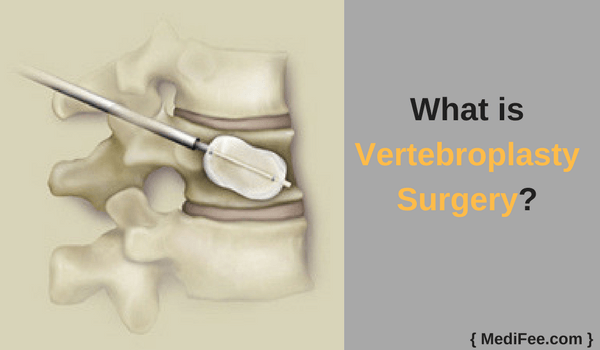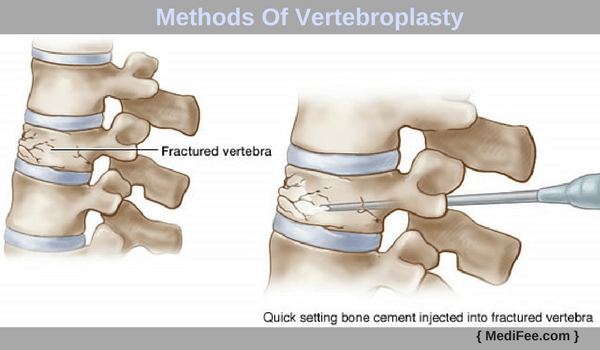Vertebroplasty
Listed below is the step by step procedure of vertebroplasty:
- What is Vertebroplasty?
- Why is Vertebroplasty Required?
- Pre-operative Preparation
- Day Before Surgery
- Procedure Day
- Methods/Techniques of Vertebroplasty
- Post Procedure
- Risks and Complications
- FAQs
What is Vertebroplasty?
Vertebroplasty is a surgical process carried out for stabilization of compression fractures in the spine of patients. It is an outpatient process which helps in reducing pain. As a result of osteoporosis, back bones or vertebrae get broken. In these broken or cracked bones, a special type of bone cement is placed. For hardening and stabilizing of fractures and spinal support, this cement is very useful. This also helps in restoring the mobility of patients.

Why is Vertebroplasty Required?
Vertebroplasty is a less invasive procedure suggested by doctors in case of patients when,
- Prolonged pain and immobility is observed
- Treatment of fractured vertebrae and back pain is not possible by traditional methods
- Deep vein thrombosis
- Respiratory problems due to fractured vertebra
- Osteoporosis acceleration
- Emotional or social issue as a result of cracked back bones
- Providing stability to the spinal fracture
- Stopping the pain resulting from the fracture of bones
Pre-operative Preparation
Prior to vertebroplasty, surgeon advises some tests including physical examination, blood tests and imaging tests. These tests help the surgeon during surgery to avoid complications.
- Physical Examination
Before performing vertebroplasty, patient's history is recorded. Physical examination is carried out at initial level to understand pain and severity of troubles in vertebrae. A nerve related injury is indicated by symptoms from physical examination. These symptoms include tingling, numbness and weakness. In the patients suffering from multiple compression deformities, Kyphotic posturing (hunchback) can be present.
- Clinical Evaluation
Clinical evaluation is carried out which involves an assessment of underlying osteoporosis, bone density, and pharmacotherapy.
- Blood Tests
Platelet count and coagulation tests are the main blood tests required to be performed prior to vertebroplasty. Preprocedural blood tests can be carried out in the patients on NSAID (nosteroidal anti inflammatory drugs).
- Imaging Tests
Imaging tests prior to vertebroplasty are very essential. Radiography of the thoracic and/or lumbar spine are mostly used for diagnosis of vertebroplasty. For accuracy of fracture confirmation, more imaging tests are required. Magnetic resonance imaging (MRI) scan is carried out for confirmation of acute or subacute vertebral fractures and understanding the morphology of crack and fractures.
Patients taking blood thinners, such as warfarin (Coumadin), clopidogrel (Plavix), or aspirin need to inform the surgeon prior to the surgery. These medications are not allowed as there are chances of complications during the surgical process. Patients need to inform the surgeon if they are allergic to any medicines prior to the surgery. This helps in preventing complications.
Day Before Surgery:
A day before surgery, all reports of preoperative diagnostic tests need to be organized and kept ready. Patient and his/her close relatives get basic details about surgical process prior to the surgery. Patients need to make sure they are clear with the instructions given by the surgeon. Patients with advance care plan (post operative care plan) need to consult with the surgeon prior to the surgery.
Procedure Day
Instructions regarding eating and drinking need to be followed by the patients. Not following these things can result in canceling or changing the surgical process. Fasting of 8-10 hours is required in most of the cases prior to vertebroplasty process.
Cleanliness needs to be maintained by patients prior to the surgery. This can be done by taking a shower or bath. Following items are not allowed to be applied prior to the surgery.
- Lotions
- Deodorants
- Perfumes
- Nail polish
Methods/Techniques of Vertebroplasty
Prior to the vertebroplasty, prophylactic intravenous antibiotics are given to all patients. This is specially helpful in immunocompromised patients. To maximize comfort of the patient and reduction in the spine curvature, padding needs to be used. Local anesthesia is given to the skin, subcutaneous tissues and periosteum. A local anesthetic lidocaine is used for this purpose. A spinal needle is required for this. Continuous monitoring of blood pressure, oxygen saturation and heart rate is done during vertebroplasty procedure.
In general many patients undergoing vertebroplasty need to get sedatives. A deeper sedation is required in rare cases for the patients suffering from pulmonary compromise. This is also applicable to patients with inability to tolerate prone positioning (face down) without anesthesia.
During vertebroplasty, high quality fluoroscopy (continuous X-ray) is used for needle placement. Placement of cement needs to be carried out under continuous fluoroscopy. Sometimes, a portable c-arm is used; though it is not ideal (procedure explained below). CT (Computed Tomographic) guidance is used with CT fluoroscopy or conventional fluoroscopy in some cases. Surgical barrier technique is used to perform vertebroplasty.
C-arm in vertebroplasty
Positioning of the fluoroscopic C-arm in proper manner is very important in successfully performing vertebroplasty.
Cranial skewing of the C-arm needs to be done to view the vertebral body “straight on.†Advanced vertebroplasty needle is required for getting access to the vertebral body.
In an X-ray suite or operation theater, local anesthesia is given to the patient before the start of the vertebroplasty under the guidance of well-trained and experienced anesthesiologist. It can be done on an outpatient basis.

By making a small puncture into the skin of the patient, a biopsy needle is inserted into the fractured vertebra. After that, a specially formulated bone cement made up of acrylic is used to fill directly into the vertebra under pressure. This fills the spaces between the bone. For stability of vertebral bone, this bone cement filling is very important. After removal of needle, the bone cement gets harder in short time. At the end, the skin puncture is wrapped with a band.
Post Procedure
Post procedure, patient lies on the back for an hour while the bone cement gets harder. Patient remains under observation for additional 1-2 hours post surgical process. In most of the cases, pain relief can be experienced right after the completion of surgical procedure. It can take up to 72 hours sometimes. Over the counter pain relief medications can be given by the surgeon on temporary basis.
It is important to note that post vertebroplasty, patients need to be accompanied by relatives or friends after getting discharge from hospital. Someone needs to be present as, there can be effect of anesthesia and pain medications. It is unsafe for patients to drive after vertebroplasty.
Pain assessment is carried out by the surgeon post vertebroplasty and possible complications are monitored.
Post surgery, patient needs to attend follow up sessions. Following precautionary measures need to be implemented after vertebroplasty procedure.
- Strenuous activities need to be avoided for 3-4 weeks.
- Smoking and alcohol consumption needs to be avoided.
- Dietary supplements, such as vitamin D and calcium need to be taken.
Risks And Complications
There are some risks associated with the vertebroplasty procedure, even though it is well tolerated in most cases by patients.
Given below are complications linked with vertebroplasty.
- Blood loss
- Fractures of ribs or other nearby bones
- Headache
- Fever
- Infection
- Hemorrhaging
- Nerve root irritation
- Extreme pain in rare cases
- Paralysis
- Bone cement leakage
FAQs
- What is percutaneous vertebroplasty?
A. Percutaneous vertebroplasty is a new technique which involves injection of medical grade cement using a needle into a fractured vertebra. This helps in reducing analgesics and stabilizes the fracture. Patients can resume normal activities in short period post vertebroplasty. The recovery period depends on overall health of the patient.
- Is it possible to get adjacent fractures after vertebral cement injections?
A. Yes, it has been reported that one vertebral body fracture indicates a threefold chance of another fracture and two fractures indicates a tenfold increase. With three fractures there is 25% chance of getting a fracture in one year.
- Which patients are eligible to undergo vertebroplasty?
A. Men and women suffering from back pain for more than 3-4 weeks and vertebral collapse debilitation are suitable candidates of evaluation for vertebroplasty. In case of patients where basic treatments such as oral pain medications, back brace, have not shown positive response, vertebroplasty is a preferred approach. Elderly patients of more than 70 years of age as well as younger patients suffering from osteoporosis as a result of long-term steroid treatment or metabolic disorders are also eligible for vertebroplasty. Vertebroplasty is used in cases where vertebral destruction occurs from malignant tumors.
More information related to Spine Surgery
- Information on Spine Surgery
- Information on Spinal Fusion Surgery
- Information on Spinal Decompression Surgery
- Information on Laser Spine Surgery
- Information on Cervical Spine Surgery
- Information on Laminectomy
- Information on Lumbar Discectomy
- Information on Lumbar Puncture
Cost of Spine Surgery in India and top cities
List of best Spine Surgeons in India and top cities
List of best Orthopedic Hospitals in India and top cities

